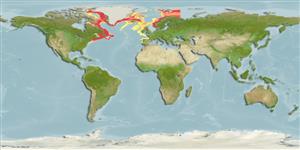Environment: milieu / climate zone / depth range / distribution range
นิเวศวิทยา
เกี่ยวกับทะเล,น้ำเค็ม สัตว์หน้าดินในเขตน้ำลึก; ระดับความลึก 165 - 1342 m (Ref. 58426), usually 165 - 215 m (Ref. 42091). Deep-water; 79°N - 38°N, 76°W - 36°E
North Atlantic: English Channel, North Sea, Norwegian coastline, Svalbard, southwestern Barents Sea, off Spitzbergen, Bear Island, the Faeroes and Iceland, southeastern coasts of Greenland. Western Atlantic: New Jersey, USA to Gulf of St. Lawrence, Canada and Greenland.
ขนาด / น้ำหนัก / Age
Maturity: Lm ? range ? - ? cm
Max length : 30.0 cm SL เพศผู้/กระเทย; (Ref. 35388); common length : 14.0 cm SL เพศผู้/กระเทย; (Ref. 6696)
Short description
สัณฐานวิทยา | ความยาวต่างๆ
Four bony knobs between and behind the eyes. Skin very rough. Body with 3-4 broad, dark vertical bands (Ref. 35388).
Benthic (Ref. 58426). Feeds on polychaetes, mysids, amphipods and pycnogonids. Spawns probably from June to July, ovarian eggs large and few (up to 220) (Ref. 6696). Female lays 200 eggs with a length of 4.5-5 mm (Ref. 35388).
Fedorov, V.V. and J.S. Nelson, 1986. Psychrolutidae. p. 1261-1264. In P.J.P. Whitehead, M.-L. Bauchot, J.-C. Hureau, J. Nielsen and E. Tortonese (eds.) Fishes of the North-eastern Atlantic and the Mediterranean. UNESCO, Paris. Vol 3. (Ref. 6696)
IUCN Red List Status (Ref. 130435)
Threat to humans
Harmless
Human uses
การประมง: ไม่มีผลประโยชน์
ข้อมูลเพิ่มเติม
อ้างอิงการเพาะเลี้ยงสัตว์น้ำประวัติการเพาะเลี้ยงสัตว์น้ำสายพันธุ์พันธุศาสตร์ElectrophoresesอัตราพันธุกรรมโรคการแปรรูปNutrientsMass conversion
เครื่องมือ
Special reports
Download XML
แหล่งที่มาจากอินเตอร์เน็ต
Estimates based on models
Preferred temperature (Ref.
123201): 0.3 - 7.7, mean 2.6 °C (based on 243 cells).
Phylogenetic diversity index (Ref.
82804): PD
50 = 0.5039 [Uniqueness, from 0.5 = low to 2.0 = high].
Bayesian length-weight: a=0.00389 (0.00180 - 0.00842), b=3.12 (2.94 - 3.30), in cm total length, based on all LWR estimates for this body shape (Ref.
93245).
ระดับชั้นอาหาร (Ref.
69278): 4.1 ±0.2 se; based on diet studies.
ความสามารถในการกลับคืนสู่ปกติ (Ref.
120179): ต่ำ, เวลาต่ำสุดที่จะทำให้ประชากรเพิ่มขึ้นเป็น 2 เท่าใช้เวลา 4.5 - 14 ปี (Fec = 66).
Fishing Vulnerability (Ref.
59153): Low to moderate vulnerability (27 of 100).
Nutrients (Ref.
124155): Calcium = 20.5 [5.0, 69.0] mg/100g; Iron = 0.431 [0.149, 1.080] mg/100g; Protein = 14.8 [12.5, 17.8] %; Omega3 = 0.349 [0.133, 0.959] g/100g; Selenium = 12.6 [4.4, 43.1] μg/100g; VitaminA = 16.5 [3.4, 78.4] μg/100g; Zinc = 0.423 [0.217, 0.837] mg/100g (wet weight);
